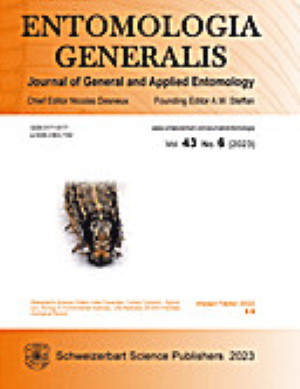蚜虫为保护蚂蚁而采取的防螨措施促进了蚂蚁-蚜虫互生关系的持续存在
IF 4.6
1区 农林科学
Q1 ENTOMOLOGY
引用次数: 0
摘要
许多研究关注蚂蚁与蚜虫之间以食物换保护的互利关系,却忽视了蚜虫对蚂蚁的潜在保护作用。为了全面了解枸杞中蚂蚁-蚜虫互作的双向服务,我们操纵了瓢虫或螨虫的存在和丰度,分析它们对蚂蚁-蚜虫互作持续性的影响。我们发现,蚂蚁为瓢虫提供了蚜虫保护,而蚜虫则为保护蚂蚁提供了防螨措施。在蚂蚁保护蚜虫方面,1)蚂蚁的存在通过减少瓢虫的出勤率而削弱了蚜虫-瓢虫丰度的正相关关系。2)蚂蚁较多的蚜虫侵染植物对瓢虫的接受程度较低(蚂蚁-瓢虫比率高于 1.75)。3)蚂蚁的存在影响瓢虫的消耗特性,包括蚜虫消耗量(减少 43.5%)、处理时间(增加 220.3%)和理论最大消耗量(减少 68.8%)。对于蚜虫对蚂蚁的保护,4)蚜虫的存在通过降低螨虫的丰度减轻了螨虫对蚂蚁的负面影响。5) 高丰度螨虫(螨蚁比超过 70)大大减少了蚂蚁的出勤率。6) 大量的蚜虫蜜露通过诱捕螨虫(每片叶超过 0.7 毫升),具有显著的抗螨效果。我们的研究表明,蚜虫为保护蚂蚁而采取的防螨措施,除了能促进蚂蚁与蚜虫的互利关系外,还能促进蚂蚁与蚜虫互利关系的持续发展。这两种保护措施都依赖于密度,这表明在瓢虫的实际应用中,基于密度优势的淹没式生物防治可能是对蚜虫产生快速影响的一种有前途的选择。有效的控制策略应侧重于将蚜虫数量减少到经济阈值以下,而不是试图根除,让蚜虫自然抑制螨虫种群。这可以有效减少杀虫剂产品的用量。本文章由计算机程序翻译,如有差异,请以英文原文为准。
Anti-mite measures of aphids for protecting ants promote persistence of ant-aphid mutualism
Numerous studies focus on food-for-protection ant-aphid mutualism while ignoring the potential aphid’s protection for ants. To obtain a comprehensive understanding of bidirectional services in ant-aphid mutualism in goji berry, we manipulated the presence and abundance of ladybugs or mites, analyzing their impact on the ant-aphid mutualism persistence. We found that ants provided aphid protection from ladybugs and aphids provided anti-mite measures for protecting ants. For aphid protection by ants, 1) ant presence eroded the positive aphid-ladybug abundance relationship by reducing ladybug attendance. 2) Aphid-infested plants with more ants were less acceptable to ladybugs (ant-ladybug ratio above 1.75). 3) Ant presence impacted consumption traits of ladybugs, including aphid consumption (43.5% less), handling time (220.3% more), and theoretical maximum consumption (68.8% less). For ant protection by aphids, 4) aphid presence alleviated negative impacts on ants caused by mites by reducing mite abundance. 5) High-abundance mites (mite-ant ratio above 70) significantly reduced ant attendance. 6) The substantial volume of aphid honeydew had remarkable anti-mite effects by trapping mites (above 0.7 ml per leaf). Besides food-for-protection mutualism, our study indicates that anti-mite measures of aphids for protecting ants could promote the persistence of ant-aphid mutualism. Both protections were density-dependent, suggesting in practical applications of ladybugs, inundative biological control based on density advantage could be a promising option for rapid impact on aphids. Effective control strategies should focus on reducing the aphid abundance below the economic threshold rather than attempting eradication, allowing aphids to naturally suppress mite populations. This could effectively reduce the dosage of pesticide products.
求助全文
通过发布文献求助,成功后即可免费获取论文全文。
去求助
来源期刊

Entomologia Generalis
生物-昆虫学
CiteScore
7.10
自引率
18.80%
发文量
72
审稿时长
>12 weeks
期刊介绍:
Its scope covers all aspects of basic and applied research dealing with insects and more broadly with arthropods inhabiting wild, agricultural and/or urban habitats. The journal also considers research integrating various disciplines and issues within the broad field of entomology and ecology.
Entomologia Generalis publishes high quality research articles on advances in knowledge on the ecology and biology of arthropods, as well as on their importance for key ecosystems services, e.g. as biological control and pollination. The journal devotes special attention to contributions providing significant advances (i) on the fundamental knowledge and on sustainable control strategies of arthropod pests (including of stored products) and vectors of diseases, (ii) on the biology and ecology of beneficial arthropods, (iii) on the spread and impact of invasive pests, and (iv) on potential side effects of pest management methods.
Entomologia Generalis welcomes review articles on significant developments in the field of entomology. These are usually invited by the editorial board, but proposals may be sent to the Editor-in-Chief for preliminary assessment by the editorial board before formal submission to the journal. The journal also considers comments on papers published in Entomologia Generalis, as well as short notes on topics that are of broader interest.
 求助内容:
求助内容: 应助结果提醒方式:
应助结果提醒方式:


